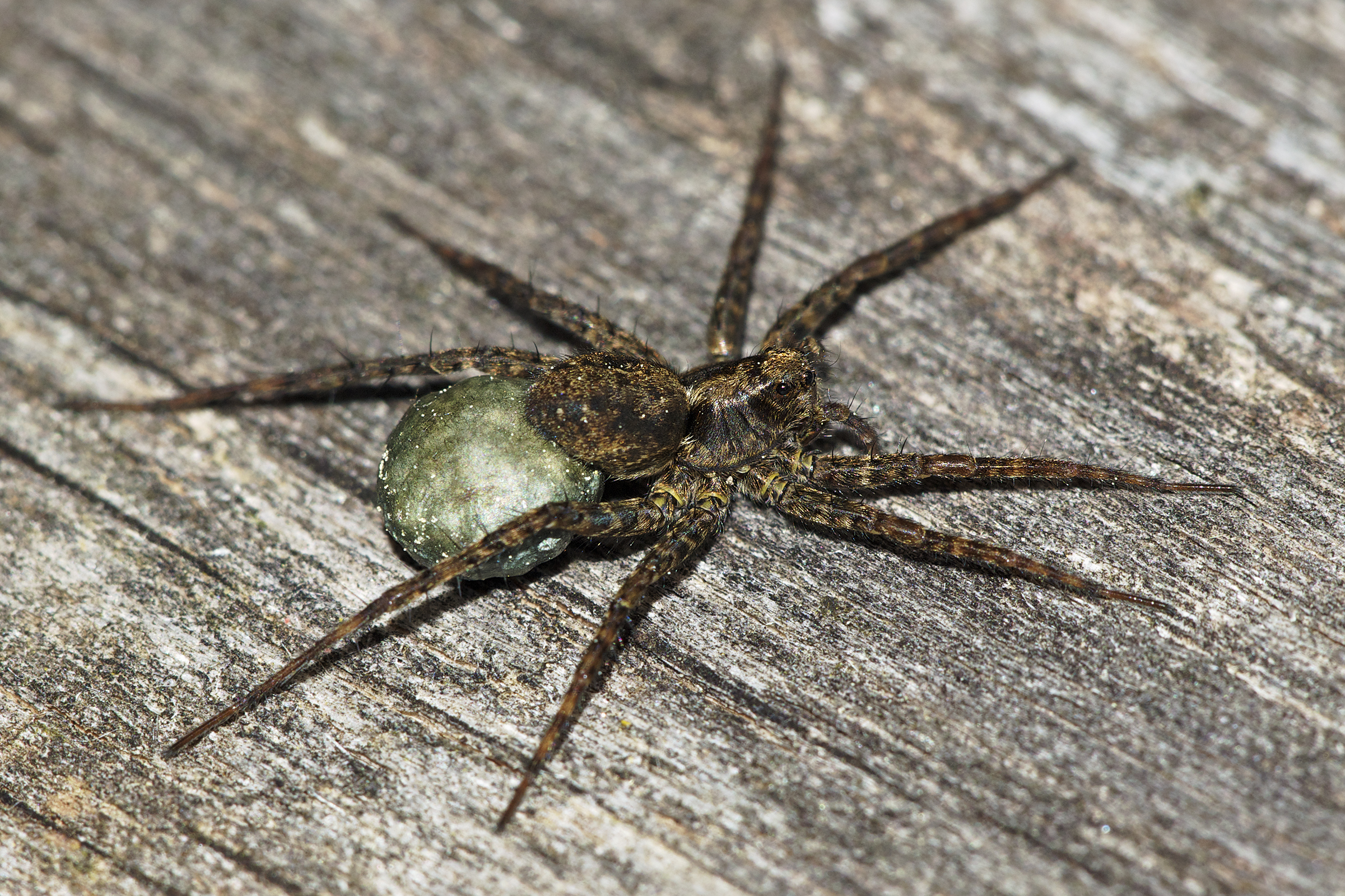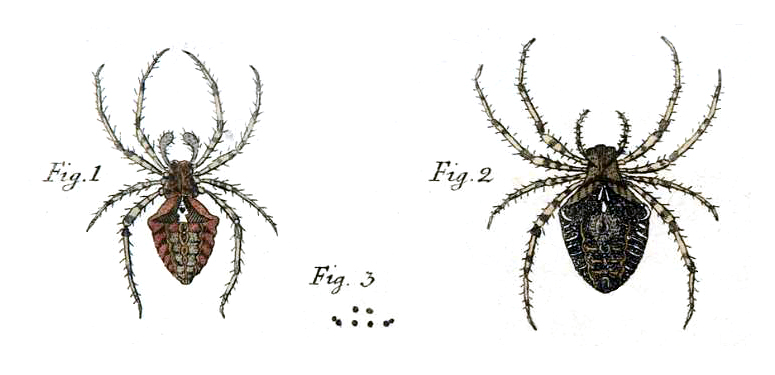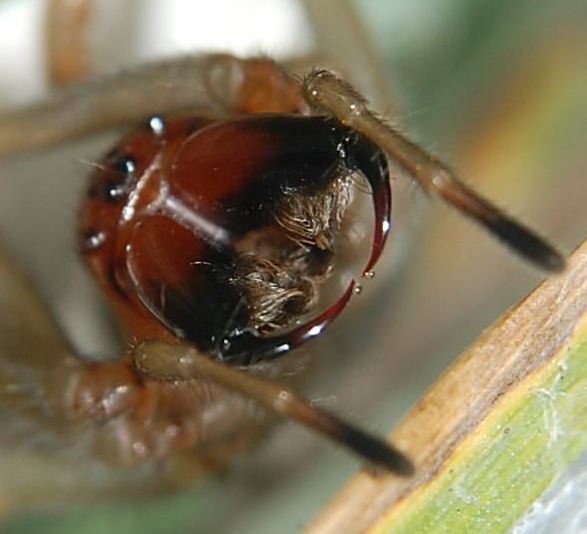|
Pardosa Amentata
''Pardosa amentata'', otherwise known as the wolf spider or spotted wolf spider is a species of spider in the genus ''Pardosa'' belonging to the family of wolf spiders, Lycosidae. The species has a widespread distribution in central Europe and northwestern Europe and are commonly found on the British Isles. The species hunts its prey on the ground rather than weaving a web. It was described in chapter 5 of the book Svenska Spindlar by the Swedish arachnologist and entomologist Carl Alexander Clerck. Description ''Pardosa amentata'' is a wolf spider between 5 mm and 8 mm in length and has a brownish coloured body with darker brown markings or spots. Its body is divided into two parts, the cephalothorax and the abdomen. The cephalothrax holds its eight eyes, four pairs of legs and the jaws, while the abdomen holds silk-producing organs called spinnerets which are situated at the rear. The females are usually slightly larger than males and carry their eggs in a round sa ... [...More Info...] [...Related Items...] OR: [Wikipedia] [Google] [Baidu] |
Carl Alexander Clerck
Carl Alexander Clerck (1709 – 22 July 1765) was a Sweden, Swedish entomologist and arachnology, arachnologist. Clerck came from a family in the petty Swedish nobility, nobility and entered the University of Uppsala in 1726. Little is known of his studies; although a contemporary of Carl Linnaeus, Linnaeus, it is unknown whether he had any contact with him during his time in Uppsala. His limited means forced him to leave university early and enter into government service, later ending up working in the administration of the City of Stockholm. His interest in natural history appears to have come at a more mature age, influenced by a lecture of Linnaeus he attended in Stockholm in 1739. In the following years he collected and categorized many spiders, published together with more general observations on the morphology and behaviour of spiders, in his ''Svenska Spindlar'' ("Swedish spiders", 1757, also known by its Latin subtitle, ''Aranei Suecici''). He also started the publication ... [...More Info...] [...Related Items...] OR: [Wikipedia] [Google] [Baidu] |
Vegetation
Vegetation is an assemblage of plant species and the ground cover they provide. It is a general term, without specific reference to particular taxa, life forms, structure, spatial extent, or any other specific botanical or geographic characteristics. It is broader than the term ''flora'' which refers to species composition. Perhaps the closest synonym is plant community, but ''vegetation'' can, and often does, refer to a wider range of spatial scales than that term does, including scales as large as the global. Primeval redwood forests, coastal mangrove stands, sphagnum bogs, desert soil crusts, roadside weed patches, wheat fields, cultivated gardens and lawns; all are encompassed by the term ''vegetation''. The vegetation type is defined by characteristic dominant species, or a common aspect of the assemblage, such as an elevation range or environmental commonality. The contemporary use of ''vegetation'' approximates that of ecologist Frederic Clements' term earth cover, a ... [...More Info...] [...Related Items...] OR: [Wikipedia] [Google] [Baidu] |
Spiders Described In 1757
Spiders ( order Araneae) are air-breathing arthropods that have eight legs, chelicerae with fangs generally able to inject venom, and spinnerets that extrude silk. They are the largest order of arachnids and rank seventh in total species diversity among all orders of organisms. Spiders are found worldwide on every continent except for Antarctica, and have become established in nearly every land habitat. , 50,356 spider species in 132 families have been recorded by taxonomists. However, there has been debate among scientists about how families should be classified, with over 20 different classifications proposed since 1900. Anatomically, spiders (as with all arachnids) differ from other arthropods in that the usual body segments are fused into two tagmata, the cephalothorax or prosoma, and the opisthosoma, or abdomen, and joined by a small, cylindrical pedicel, however, as there is currently neither paleontological nor embryological evidence that spiders ever had a separate t ... [...More Info...] [...Related Items...] OR: [Wikipedia] [Google] [Baidu] |
Spiders Of Russia
Spiders (order Araneae) are air-breathing arthropods that have eight legs, chelicerae with fangs generally able to inject venom, and spinnerets that extrude silk. They are the largest order of arachnids and rank seventh in total species diversity among all orders of organisms. Spiders are found worldwide on every continent except for Antarctica, and have become established in nearly every land habitat. , 50,356 spider species in 132 families have been recorded by taxonomists. However, there has been debate among scientists about how families should be classified, with over 20 different classifications proposed since 1900. Anatomically, spiders (as with all arachnids) differ from other arthropods in that the usual body segments are fused into two tagmata, the cephalothorax or prosoma, and the opisthosoma, or abdomen, and joined by a small, cylindrical pedicel, however, as there is currently neither paleontological nor embryological evidence that spiders ever had a separate th ... [...More Info...] [...Related Items...] OR: [Wikipedia] [Google] [Baidu] |
Spiders Of Europe
Spiders ( order Araneae) are air-breathing arthropods that have eight legs, chelicerae with fangs generally able to inject venom, and spinnerets that extrude silk. They are the largest order of arachnids and rank seventh in total species diversity among all orders of organisms. Spiders are found worldwide on every continent except for Antarctica, and have become established in nearly every land habitat. , 50,356 spider species in 132 families have been recorded by taxonomists. However, there has been debate among scientists about how families should be classified, with over 20 different classifications proposed since 1900. Anatomically, spiders (as with all arachnids) differ from other arthropods in that the usual body segments are fused into two tagmata, the cephalothorax or prosoma, and the opisthosoma, or abdomen, and joined by a small, cylindrical pedicel, however, as there is currently neither paleontological nor embryological evidence that spiders ever had a separate t ... [...More Info...] [...Related Items...] OR: [Wikipedia] [Google] [Baidu] |
Winter
Winter is the coldest season of the year in polar and temperate climates. It occurs after autumn and before spring. The tilt of Earth's axis causes seasons; winter occurs when a hemisphere is oriented away from the Sun. Different cultures define different dates as the start of winter, and some use a definition based on weather. When it is winter in the Northern Hemisphere, it is summer in the Southern Hemisphere, and vice versa. In many regions, winter brings snow and freezing temperatures. The moment of winter solstice is when the Sun's elevation with respect to the North or South Pole is at its most negative value; that is, the Sun is at its farthest below the horizon as measured from the pole. The day on which this occurs has the shortest day and the longest night, with day length increasing and night length decreasing as the season progresses after the solstice. The earliest sunset and latest sunrise dates outside the polar regions differ from the date of the winte ... [...More Info...] [...Related Items...] OR: [Wikipedia] [Google] [Baidu] |
Heathland
A heath () is a shrubland habitat found mainly on free-draining infertile, acidic soils and characterised by open, low-growing woody vegetation. Moorland is generally related to high-ground heaths with—especially in Great Britain—a cooler and damper climate. Heaths are widespread worldwide but are fast disappearing and considered a rare habitat in Europe. They form extensive and highly diverse communities across Australia in humid and sub-humid areas where fire regimes with recurring burning are required for the maintenance of the heathlands.Specht, R.L. 'Heathlands' in 'Australian Vegetation' R.H. Groves ed. Cambridge University Press 1988 Even more diverse though less widespread heath communities occur in Southern Africa. Extensive heath communities can also be found in the Texas chaparral, New Caledonia, central Chile, and along the shores of the Mediterranean Sea. In addition to these extensive heath areas, the vegetation type is also found in scattered locations acro ... [...More Info...] [...Related Items...] OR: [Wikipedia] [Google] [Baidu] |
Blanket Bog
Blanket bog or blanket mire, also known as featherbed bog, is an area of peatland, forming where there is a climate of high rainfall and a low level of evapotranspiration, allowing peat to develop not only in wet hollows but over large expanses of undulating ground. The blanketing of the ground with a variable depth of peat gives the habitat type its name. Blanket bogs are found extensively throughout the northern hemisphere - well-studied examples are found in Ireland and Scotland, but vast areas of North American tundra also qualify as blanket bogs. In Europe, the southernmost edge of range of this habitat has been recently mapped in the Cantabrian Mountains, northern Spain, but the current distribution of blanket bogs globally remains unknown. In the southern hemisphere they are less well-developed due to the relatively low latitudes of the main land areas, though similar environments are reported in Patagonia, the Falkland Islands and New Zealand. The blanket bogs known as 'f ... [...More Info...] [...Related Items...] OR: [Wikipedia] [Google] [Baidu] |
Moorland
Moorland or moor is a type of habitat found in upland areas in temperate grasslands, savannas, and shrublands and montane grasslands and shrublands biomes, characterised by low-growing vegetation on acidic soils. Moorland, nowadays, generally means uncultivated hill land (such as Dartmoor in South West England), but also includes low-lying wetlands (such as Sedgemoor, also South West England). It is closely related to heath, although experts disagree on what precisely distinguishes these types of vegetation. Generally, moor refers to highland and high rainfall zones, whereas heath refers to lowland zones which are more likely to be the result of human activity. Moorland habitats mostly occur in tropical Africa, northern and western Europe, and neotropical South America. Most of the world's moorlands are diverse ecosystems. In the extensive moorlands of the tropics, biodiversity can be extremely high. Moorland also bears a relationship to tundra (where the subsoil is permafros ... [...More Info...] [...Related Items...] OR: [Wikipedia] [Google] [Baidu] |
Hedge
A hedge or hedgerow is a line of closely spaced shrubs and sometimes trees, planted and trained to form a barrier or to mark the boundary of an area, such as between neighbouring properties. Hedges that are used to separate a road from adjoining fields or one field from another, and are of sufficient age to incorporate larger trees, are known as hedgerows. Often they serve as windbreaks to improve conditions for the adjacent crops, as in bocage country. When clipped and maintained, hedges are also a simple form of topiary. A hedge often operates as, and sometimes is called, a "live fence". This may either consist of individual fence posts connected with wire or other fencing material, or it may be in the form of densely planted hedges without interconnecting wire. This is common in tropical areas where low-income farmers can demarcate properties and reduce maintenance of fence posts that otherwise deteriorate rapidly. Many other benefits can be obtained depending on the specie ... [...More Info...] [...Related Items...] OR: [Wikipedia] [Google] [Baidu] |
Saltmarsh
A salt marsh or saltmarsh, also known as a coastal salt marsh or a tidal marsh, is a coastal ecosystem in the upper coastal intertidal zone between land and open saltwater or brackish water that is regularly flooded by the tides. It is dominated by dense stands of salt-tolerant plants such as herbs, grasses, or low shrubs. These plants are terrestrial in origin and are essential to the stability of the salt marsh in trapping and binding sediments. Salt marshes play a large role in the aquatic food web and the delivery of nutrients to coastal waters. They also support terrestrial animals and provide coastal protection. Salt marshes have historically been endangered by poorly implemented coastal management practices, with land reclaimed for human uses or polluted by upstream agriculture or other industrial coastal uses. Additionally, sea level rise caused by climate change is endangering other marshes, through erosion and submersion of otherwise tidal marshes. However, recent ackn ... [...More Info...] [...Related Items...] OR: [Wikipedia] [Google] [Baidu] |
Marsh
A marsh is a wetland that is dominated by herbaceous rather than woody plant species.Keddy, P.A. 2010. Wetland Ecology: Principles and Conservation (2nd edition). Cambridge University Press, Cambridge, UK. 497 p Marshes can often be found at the edges of lakes and streams, where they form a transition between the aquatic and terrestrial ecosystems. They are often dominated by grasses, rushes or reeds. If woody plants are present they tend to be low-growing shrubs, and the marsh is sometimes called a carr. This form of vegetation is what differentiates marshes from other types of wetland such as swamps, which are dominated by trees, and mires, which are wetlands that have accumulated deposits of acidic peat. Marshes provide habitats for many kinds of invertebrates, fish, amphibians, waterfowl and aquatic mammals. This biological productivity means that marshes contain 0.1% of global sequestered terrestrial carbon. Moreover, they have an outsized influence on climate resi ... [...More Info...] [...Related Items...] OR: [Wikipedia] [Google] [Baidu] |





.jpeg/1200px-Amrum_(187753235).jpeg)


